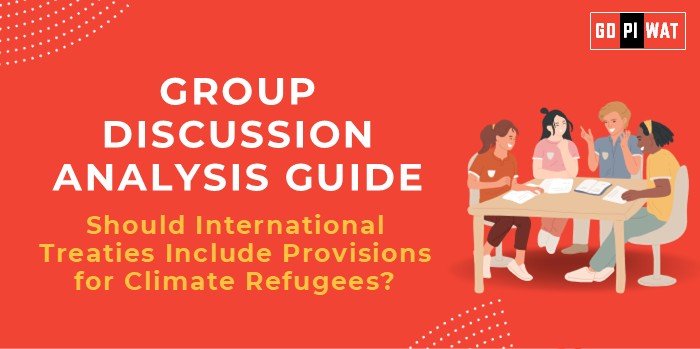📋 Group Discussion Analysis Guide: Should International Treaties Include Provisions for Climate Refugees?
🌐 Introduction to the Topic
📖 Opening Context
Climate change is a global crisis that not only disrupts ecosystems but also forces millions to flee their homes. The growing prevalence of “climate refugees” challenges existing international frameworks, which currently lack binding provisions to address their plight. As climate change accelerates, integrating their needs into international treaties is critical.
📜 Topic Background
The concept of climate refugees emerged in the 1980s, but international law, including the 1951 Refugee Convention, does not formally recognize them. Recent disasters like Cyclone Idai in Mozambique and rising sea levels in Pacific Island nations highlight the urgency of addressing this gap.
📊 Quick Facts and Key Statistics
- 🌍 Displacement Due to Climate Change: 21.6 million annually (UNHCR, 2023) – More than those displaced by conflict.
- 🌊 Affected Nations: Bangladesh, Kiribati, and the Maldives face severe threats due to rising sea levels.
- 💰 Economic Impact: $300 billion in losses annually by 2030 if current trends persist (World Bank).
- ⚖️ Legal Status: No legal recognition under international refugee law.
- 🌐 Global Action: Over 180 countries committed to the Paris Agreement but without binding refugee provisions.
🤝 Stakeholders and Their Roles
- 🌐 United Nations (UN): Advocate for policy inclusion through bodies like UNHCR and the Paris Agreement.
- 🏛️ Nation-States: Develop domestic policies and provide asylum or resettlement programs.
- 📢 NGOs: Offer legal and humanitarian support for displaced individuals.
- 🏢 Private Sector: Invest in climate mitigation and adaptation technologies.
🏆 Achievements and Challenges
✨ Achievements
- 🌍 Global Compact on Migration (2018): Included non-binding mentions of climate-related migration.
- 🛂 Regional Initiatives: The Pacific Access Category Visa (New Zealand) offers pathways for climate-displaced individuals.
⚠️ Challenges
- ⚖️ Legal Gaps: Lack of binding international frameworks recognizing climate refugees.
- 🏛️ Political Resistance: Sovereignty concerns often hinder collective action.
- 💰 Economic Constraints: Resettling climate refugees demands significant funding and resources.
🌍 Global Comparisons
- ✅ Estonia: Digital solutions support data for climate migration.
- 🌱 Bangladesh: National Adaptation Plan includes proactive resettlement efforts.
📖 Case Studies
- 🇰🇮 Kiribati: Purchased land in Fiji to resettle its citizens displaced by rising sea levels.
💡 Structured Arguments for Discussion
- 🛠️ Supporting Stance: “Incorporating climate refugee provisions aligns with global justice and human rights imperatives.”
- 🛡️ Opposing Stance: “Such treaties might burden developing countries already struggling with limited resources.”
- ⚖️ Balanced Perspective: “While provisions are necessary, implementation should balance national capacities with global responsibility.”
🎯 Effective Discussion Approaches
🔑 Opening Approaches
- 📊 “21.6 million people displaced annually by climate change calls for urgent legal frameworks.”
- 📖 “Kiribati’s purchase of land in Fiji exemplifies the need for structured solutions.”
⚙️ Counter-Argument Handling
- 🔄 Example: “Addressing sovereignty concerns requires regional approaches, such as bilateral agreements, to ensure fairness.”
🧠 Strategic Analysis of Strengths and Weaknesses
SWOT Analysis:
- 💪 Strengths: Growing global awareness; success of regional initiatives.
- 🛠️ Weaknesses: Legal ambiguity in international frameworks; resistance from major economies.
- 🌟 Opportunities: Collaboration through UN platforms; role of technology in managing migration data.
- ⚠️ Threats: Political polarization; escalating climate disasters.
🏫 Connecting with B-School Applications
📚 Real-World Applications
- 🌍 Explore intersections of international law and sustainability in courses like Global Policy or CSR.
🎓 Sample Interview Questions
- ❓ “How can businesses contribute to addressing climate displacement?”
- ❓ “What role should developing countries play in supporting climate refugees?”
💡 Insights for B-School Students
- 📈 Propose CSR initiatives focusing on refugee integration.
- ⚖️ Explore international policy frameworks for internships or research.


